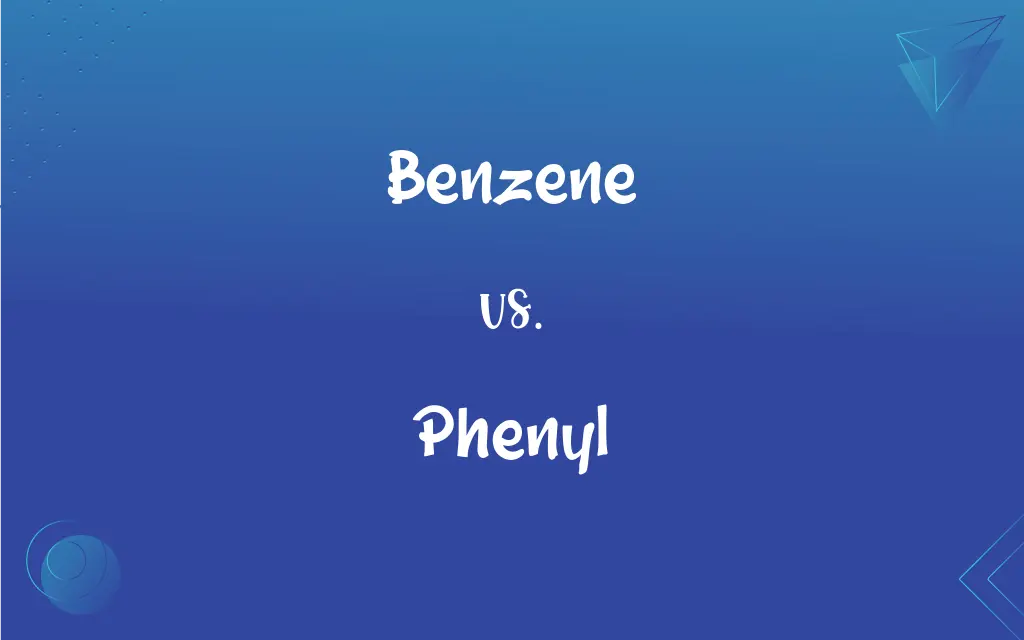Benzene vs. Phenyl: What's the Difference?
Edited by Aimie Carlson || By Harlon Moss || Updated on October 24, 2023
Benzene is a six-membered aromatic hydrocarbon, while phenyl is a benzene ring minus one hydrogen atom, acting as a substituent.

Key Differences
Benzene is a fundamental organic molecule recognized for its unique hexagonal structure comprising six carbon atoms each bonded to a hydrogen atom. This configuration gives benzene its aromatic nature, characterized by its stability and resonance. In contrast, phenyl refers to the same hexagonal structure of benzene but lacking one hydrogen atom. Instead of this hydrogen atom, the phenyl group attaches itself to some other atom or group, acting as a substituent in various organic compounds.
When discussing benzene, it's often in the context of a stand-alone molecule, a volatile, colorless, and flammable liquid that plays a foundational role in organic chemistry. On the other hand, phenyl is never seen in isolation but always as part of a larger molecule, serving a vital function in the realm of organic synthesis.
Chemically, benzene's resonance and delocalized electrons make it particularly stable, despite being a compound with unsaturated double bonds. Phenyl, however, doesn't possess this stability independently. Instead, it imparts the characteristics of benzene to the compounds it's part of, influencing their behavior and reactivity.
From a practical standpoint, benzene is a crucial industrial chemical used to produce a myriad of derivatives and is often an intermediate in the synthesis of other chemicals. Phenyl, being a substituent, plays a role in the structural composition and properties of various molecules, impacting their chemical nature and reactions.
In essence, while both benzene and phenyl originate from the same structural foundation, their roles, behaviors, and implications in the field of organic chemistry are distinct, with benzene being an independent molecule and phenyl acting as a modifying group.
ADVERTISEMENT
Comparison Chart
Nature
Independent molecule.
Substituent in other molecules.
Hydrogen Atoms
Contains six hydrogen atoms.
Lacks one hydrogen atom.
Existence
Exists as a stand-alone molecule.
Always part of a larger molecule.
Chemical Stability
Stable due to resonance and delocalized electrons.
Doesn't possess independent stability but imparts benzene's characteristics.
Typical Role
Fundamental in organic chemistry and industrial synthesis.
Influences the structural composition and properties of molecules it's attached to.
ADVERTISEMENT
Benzene and Phenyl Definitions
Benzene
An important industrial chemical used to produce various derivatives.
Benzene is a precursor for many petrochemical products.
Phenyl
Never exists in isolation but as part of larger molecules.
The molecule contained a phenyl group attached to a carbon chain.
Benzene
Often acts as an intermediate in chemical synthesis.
Many organic reactions start with benzene as the foundational compound.
Phenyl
A benzene ring minus one hydrogen atom, serving as a substituent.
The phenyl group in the compound enhanced its reactivity.
Benzene
A colorless, volatile, and flammable aromatic hydrocarbon.
Benzene is an essential organic solvent in the laboratory.
Phenyl
Imparts characteristics of benzene to molecules it's attached to.
The phenyl group introduced aromatic properties to the compound.
Benzene
A six-membered ring compound with alternating double bonds.
The alternating double bonds give benzene its resonance stability.
Phenyl
Influences the properties and behavior of compounds it's part of.
The presence of the phenyl group altered the compound's solubility.
Benzene
Possesses a unique stability due to resonance.
Despite its double bonds, benzene is unusually stable.
Phenyl
A common structural component in various organic compounds.
Aspirin contains a phenyl ring in its molecular structure.
Benzene
A colorless, flammable, toxic, liquid aromatic hydrocarbon, C6H6, derived from petroleum and used in or to manufacture a wide variety of chemical products, including DDT, detergents, insecticides, and motor fuels. Also called benzol.
Phenyl
An aromatic hydrocarbon unit, C6H5, that can occur as a substituent in an organic compound or as an ion or radical, structurally related to benzene.
Phenyl
(organic chemistry) A univalent hydrocarbon radical (C6H5) formally derived from benzene by the removal of a hydrogen atom, and the basis of an immense number of aromatic derivatives.
Phenyl
A hydrocarbon radical (C6H5) regarded as the essential residue of benzene, and the basis of an immense number of aromatic derivatives.
FAQs
What is benzene's molecular structure?
Benzene has a hexagonal ring structure with alternating double bonds.
Can benzene be seen in everyday products?
Yes, benzene is used as a precursor in the production of various common chemicals.
How does a phenyl group affect a compound's properties?
The phenyl group can influence a compound's reactivity, stability, and other chemical properties.
Is benzene a stable molecule?
Yes, benzene's resonance and delocalized electrons contribute to its stability.
How does phenyl differ from benzyl?
While both derive from benzene, phenyl is a benzene ring minus one hydrogen, whereas benzyl includes a CH2 group.
How do scientists detect the presence of benzene?
Techniques like mass spectrometry and gas chromatography are used to detect benzene.
Is phenyl a stand-alone molecule?
No, phenyl always exists as part of a larger molecule.
How do molecules connect to the phenyl group?
Molecules attach to the phenyl group at the position where the hydrogen atom is missing.
Are there compounds with fused phenyl rings?
Yes, compounds like naphthalene have two fused phenyl rings.
Are benzene's fumes harmful?
Yes, prolonged exposure to benzene vapors can be harmful to health.
Is phenyl present in pharmaceuticals?
Yes, the phenyl group is a component in various pharmaceutical compounds.
Is benzene a base component for other chemicals?
Yes, benzene serves as an intermediate for synthesizing many other chemicals.
What products are derived from benzene?
Benzene derivatives include styrene, ethylbenzene, and many others.
Why is benzene's resonance important?
Resonance gives benzene its unique stability despite its unsaturated nature.
Can phenyl exist independently?
No, phenyl always acts as a substituent in other molecules.
How does phenyl impact a molecule's solubility?
The presence of a phenyl group can alter a compound's polarity, affecting its solubility.
Is benzene naturally occurring?
Benzene is found in crude oil and can also result from natural processes like volcanic eruptions.
How is benzene produced industrially?
Benzene is commonly derived from petrochemical processes, such as the catalytic reforming of naphtha.
Can a compound contain multiple phenyl groups?
Yes, compounds can have multiple phenyl groups attached, influencing their behavior.
Why is phenyl important in organic synthesis?
The phenyl group modifies and enhances the properties of molecules in synthesis.
About Author
Written by
Harlon MossHarlon is a seasoned quality moderator and accomplished content writer for Difference Wiki. An alumnus of the prestigious University of California, he earned his degree in Computer Science. Leveraging his academic background, Harlon brings a meticulous and informed perspective to his work, ensuring content accuracy and excellence.
Edited by
Aimie CarlsonAimie Carlson, holding a master's degree in English literature, is a fervent English language enthusiast. She lends her writing talents to Difference Wiki, a prominent website that specializes in comparisons, offering readers insightful analyses that both captivate and inform.































































